for my Penguin brief.
I have done some research into the top cookbooks and then
I might carry out my own survey based on these ones.
-The 50 best cookbooks of all time
As chosen by Observer Food Monthly's expert team. Part 1: Numbers 50-11 http://www.guardian.co.uk/lifeandstyle/2010/aug/13/50-best-cookbooks-ofm
50 MOMOFUKU David Chang
(Absolute Press, 2010)
 Buy it
Buy it
New York-based Chang's Korean-based food makes him the one of hottest chefs in the world right now. Signature dish: chicharrón (fried pork rind)
49 OPERA DELL'ARTE DEL CUCINARE Bartolomeo Scappi
(The Collected Works of Cooking Art, 1570)

"The Renaissance of Dante and Michelangelo translated into the kitchen," says Bill Buford of this 1,000-recipe collection from Pope Pius V's cook, translated in 2008.
48 THE HANDMADE LOAF Dan Lepard
(Mitchell Beazley, 2004)
 Buy it
Buy it
An inspirational guide to bread-making using wild yeast from the fashion photographer turned master baker. Not for bread-machine owners.
47 WITH BOLD KNIFE & FORK MFK Fisher
(Perigree, 1969)
 Buy it
Buy it
A "poet of the appetites" according to John Updike, and this is as literary a cookbook as you'll find, with the added bonus of 140 recipes.
46 CATALAN CUISINE Colman Andrews
(Headline, 1988)
 Buy it
Buy it
The founder editor of Saveur magazine's homage to "Europe last great culinary secret" that has now become the standard reference for restaurant kitchens of the region
45 THE ART OF MEXICAN COOKING Diana Kennedy
(Bantam, 1989)
 Buy it
Buy it
Classic reference work by Brit who has lived in Mexico since 1957. Often referred to as the Julia Child of that country's cooking, and loved by Wahaca's Thomasina Miers.
44 ACTION COOK BOOK Len Deighton
(Jonathan Cape, 1965)
 Buy it
Buy it
Classic cookery "strips" from the Observer, Deighton is still the person Rachel Cooke turns to for sauces. If your bearnaise is separating, he's your man.
43 INDIAN VEGETARIAN COOKERY Jack Santa Maria
(Rider and Co, 1973)
 Buy it
Buy it
Authoritative authentic recipes from the greatest vegetarian nation. A book to lovingly splatter with turmeric-died dhal. His sazi pulau is particularly good.
42 HOW TO EAT Nigella Lawson
(Chatto & Windus, 1998)
 Buy it
Buy it
Her first book with its passionate descriptions of comfort eating was revolutionary at the time, selling 300,000. Ironically, given she became the 'queen of food porn', there are few pictures.
41 FRENCH COOKING IN 10 MINUTES Edouard de Pomiane
(Bruno Cassirer, 1948)
 Buy it
Buy it
Raymond Blanc says Pomaine is his "hero", and it's easy to see why from this short, delightful book that's as much a work of philosophy. "For everyone who has only an hour for lunch or dinner and yet wants half an hour of peace," says the author.
40 PLENTY Yotam Ottolenghi
(Ebury, 2010)
 Buy it
Buy it
From pear crostini to scrambled smoky duck eggs on sourdough this meat-free collection of seductive recipes brings vegetarian eating bang up to date.
39 ON FOOD AND COOKING Harold McGee
(Simon & Schuster, 1984)
 Buy it
Buy it
An entertaining, thorough examination of the science of cooking – not surprisingly Heston Blumenthal's choice of book on Desert Island Discs.
38 THE INDEPENDENT COOK Jeremy Round
(Barrie & Jenkins, 1988)
 Buy it
Buy it
The Independent writer who tragically died aged 32. Round wrote beautifully and passionately about British seasonal cookery and was feted by food lovers from Elizabeth David to Marco Pierre White.
37 MEDITERRANEAN SEAFOOD Alan Davidson
(Penguin, 1972)
 Buy it
Buy it
The first book by the brilliant British diplomat and chronicler of all things food-related whose writing was discovered by Elizabeth David when he documented how to cook the fish he saw on the Tunis dockside.
36 PLATS DU JOUR Patience Gray and Primrose Boyd
(Penguin, 1957)
 Buy it
Buy it
Published when pasta still considered outlandish, with illustrations by the great David Gentleman. One of Jane Grigson's favourites.
35 THE RIVER COTTAGE MEAT BOOK Hugh Fearnley-Whittingstall
(Hodder & Stoughton, 2004)
 Buy it
Buy it
Will restart your relationship with your local butcher – everything you need and should know about the slaughter, preparation and cooking of animals.
34 LA CUISINE GOURMANDE Michel Guérard
(Macmillan, 1978)
 Buy it
Buy it
A favourite of Simon Hopkinson – who raves about Guérard's beef stew flavoured with orange peel. Out of print, but you'll find secondhand copies online.
33 JAPANESE COOKING Shizuo Tsuji
(Kodansha International, 1980)
 Buy it
Buy it
The fundamentals of Japanese food – including 16 pages on preparing sashimi - from a man who ran the country's largest cookery school and owned one of the world's largest private collections of Bach recordings.
32 THE GREENS COOKBOOK Deborah Madison and Edward Espe Brown
(Broadway, 1987)
 Buy it
Buy it
Revolutionised vegetarian cooking. Madison is a Californian graduate of Alice Waters's Chez Panisse, a champion of local food and student of Zen Buddhism. Key dish: black bean chili.
31 THE COOK'S COMPANION Stephanie Alexander
(Viking, 1996)
 Buy it
Buy it
Passionate, meticulous 1,000-page encyclopaedia from Australia's one-woman answer to Delia, Jamie and Hugh. Includes her famous take on Queen of Puddings.
30 PORK AND SONS Stéphane Reynaud
(Phaidon, 2007)
 Buy it
Buy it
A celebration of all things pig, rooted in Reynaud's upbringing in the Ardeche. Starts with a slaughter – the author attended his first at the age of seven – which puts the cute illustrations in their proper context.
29 KEEP IT SIMPLE Alastair Little
(Conran Octopus, 1993)
 Buy it
Buy it
Accurately subtitled "a fresh look at classic cooking" the clear, concise recipes show why Little is still lovingly referenced as the godfather of modern British cooking.
28 MORO: THE COOKBOOK Sam and Sam Clark
(Ebury 2001)
 Buy it
Buy it
Classic Mediterranean cooking from husband and wife team behind award-winning east London restaurant. Full of useful touches, such as an index of suppliers.
27 LES SECRETS DE LA MèRE BRAZIER Roger Moreau, Roger Garnier, Jacott Brazier, Paul Bocuse
(Solar, 1977)
 Buy it
Buy it
Revered by Bill Buford, Eugenie Brazier was the first woman chef to win three Michelin stars and the first to win two sets of three. The most significant "mères" of French cooking." Signature dish: gratinée Lyonnaise. Bill Buford
26 CLASSIC CHINESE COOKBOOK Yan-kit So
(Dorling Kindersley, 1984)
 Buy it
Buy it
Born in Guangdong province but raised in Hong Kong, before living in India and then London, the late Yan Kit-So was as much cultural historian as cook - she was involved in the oriental antiquities department of the British Museum. This was her first book, an award-winning run through the essentials of authentic Chinese cookery that still stands today.
25 TRADITIONAL SPANISH COOKING Janet Mendel
(Garnet Publishing, 1996)
 Buy it
Buy it
Journalist Mendel is an American who has lived in southern Spain for more than 30 years, immersing herself in the country's culture and cooking. This is an authoritative blend of both, with little asides – crema catalana is the Father's Day dessert of choice, apparently – making it more than just a thorough compendium of recipes.
24 THE COMPLETE GUIDE TO THE ART OF MODERN COOKERY Auguste Escoffier
(John Wiley & Sons, 1983)
 Buy it
Buy it
Exhaustive, 5,000-recipe guide from the father of French food, whose translators, suitably enough, met while working at the Savoy itself, where Escoffier, head of restaurant services, invented the peach melba. Everything is here, from sauces to game, salads to jam, but it's not for novices, and is as much reference book as cookbook.
23 NOSE TO TAIL EATING: A KIND OF BRITISH COOKING Fergus Henderson
(Bloomsbury, 1999)
 Buy it
Buy it
The book that took Henderson's waste-nothing take on meat-eating worldwide. The philosophy is simple – "If you're going to kill the animal it seems only polite to use the whole thing" – but has proved revolutionary, introducing a generation to rough but beautiful cuts they'd never previously considered, or might even have been a little scared of. Start with the roast bone marrow and parsley salad.
22 THE FOUR SEASONS COOKERY BOOK Margaret Costa
(Thomas Nelson, 1970)
 Buy it
Buy it
"A guiding light," was how Nigel Slater described Costa in her obituary for the Guardian in 1999. She'd come to prominence by replacing Robert Carrier as the Sunday Times cookery writer, and although this was her only significant book, it's hugely influential. Divided by ingredients – unusual back in 1970 – it proved a key introduction to the now commonplace notion of the absolute importance of sourcing.
21 MASTERING THE ART OF FRENCH COOKING Julia Child, Simone Beck & Louise Bertholle
(Knopf, 1961)
 Buy it
Buy it
Two volumes that revolutionised cooking in America, its influence extending into the digital age by inspiring the popular food blog that ultimately led to Oscar-nominated Meryl Streep vehicle Julie and Julia. Perhaps a bit dated – no one would recommend using tinned salmon these days – and not as straightforward as Child's profile as the American Delia might suggest.
20 GOOD THINGS IN ENGLAND Florence White
(Jonathan Cape, 1932)
 Buy it
Buy it
Founder of the English Folk Cookery Association, White was one of the earliest British journalists to write about food. This pioneering collection of more than 800 recipes, some dating as far back as the 14th century, is the finest expression of White's passion for the nation's cookery, which she believed was "the finest in the world". A lost classic, it was finally republished by Persephone in 1999.
19 THE RICE BOOK Sri Owen
(Doubleday, 1993)
 Buy it
Buy it
A labour of love and extensive research. Sumatran-born Owen, an authority on Indonesian food, visited a dozen rice growing countries while preparing the definitive volume on the versatile grain. Lovingly packaged, it's a mix of history – rice is part of the creation myth in Java, apparently – and 200 recipes drawn from Afghanistan to Korea.
18 AN INVITATION TO INDIAN COOKING Madhur Jaffrey
(HarperCollins, 1973)
 Buy it
Buy it
Jaffrey remains synonymous with Indian food for anyone who grew up in the 70s and 80s, her first book curing a nation of ignoramuses of the notion that what they washed down with lager on a Friday night was the same as authentic cooking from the subcontinent.
17 A PLATTER OF FIGS AND OTHER RECIPES David Tanis
(Artisan, 2008)
 Buy it
Buy it
A favourite of Bill Buford and Thomasina Miers. When he's not head chef at Chez Panisse, Tanis lives in Paris, where he continues to cook, but the same way many of us do, for small groups of friends. These evenings provided the inspiration for the 24 menus here, but reveal something about the author too, taking in his travels to north Africa and the Pacific north-west of the United States.
16 ENGLISH SEAFOOD COOKERY Rick Stein
(Penguin, 1988)
 Buy it
Buy it
A short, rather slight-looking book that is a real boon when you find yourself unsure of what to do with fish or shellfish. The fish stew with saffron and cream, is recommended. Stein is also good on sauces and other accompaniments: hollandaise, buerre blanc, rouille, and flavoured butters.Rachel Cooke
15 JAMIE'S ITALY Jamie Oliver
(Michael Joseph, 2005)
 Buy it
Buy it
He may have expanded the nations palates, killed off the turkey twizzler and cried on TV a lot, yet Jamie Oliver's first love was Italian food, and with this book it shows. Assembled from his time haring round the Italian regions it is packed with hearty, flavoursome dishes which are hard to mess up.
14 THE CONSTANCE SPRY COOKERY BOOK Rosemary Hume and Constance Spry
(Dent, 1956)
 Buy it
Buy it
Includes the original recipe for coronation chicken, invented for Elizabeth's ascent to the throne in 1953 (original domestic goddess Spry also did the flowers in Westminster Abbey). Hume and Spry opened the Domestic Science School in Cranbourne in 1946: the former had more expertise in the kitchen, the latter more celebrity cachet and their book will still help you handle everything from breakfast to cocktail parties.
13 THE COMPLETE ROBUCHON Joel Robuchon
(Grub St, 2008)
 Buy it
Buy it
It's all here, every quirky piece of orthodox French methodology, mixed in with preparations that are distinctly Robuchon: those buttery mashed potatoes, madeleines that are the best in France ; and a boeuf à la Provencal that, made with cheeks poked with lardons and cooked atop a half-pound of pork rind, may be the only the meaty stew that never dries out. Bill Buford
12 DELIA'S COMPLETE HOW TO COOK Delia Smith
(BBC, 2009)
 Buy it
Buy it
Such is the power of Delia that her How to Cook TV show is credited with raising sales of cranberries by 200% after they were featured in one recipe on the programme. That common touch is carried over into her books and few do the basics better than this supremely useful 350-recipe, step-by-step guide. If you need something to hold you by the hand, this is it.
11 CHEZ PANISSE MENU COOKBOOK Alice Waters
(Random House, 1982)
 Buy it
Buy it
Chez Panisse in Berkeley, California was where Alice Waters, champion of all things local and organic, put her vision of seasonal, sustainable cooking into practice when it opened in 1971. The first of many books, this balances her ethos with 120 menus from the restaurant. An influential campaigner, Waters had long been pushing for an organic vegetable garden in the White House and got one in 2008, after writing to Michelle Obama.
10 GREAT DISHES OF THE WORLD Robert Carrier
(Marshall Cavendish, 1963)
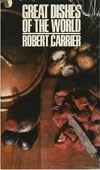 Buy it
Buy it
Good cookery books capture the culinary zeitgeist; truly great cookery books shape it. Few are as important or, frankly, as indispensable as Carrier'sGreat Dishes of the World, which gently explained to a Britain for whom the memories of rationing were still fresh, that there really was a world of food beyond their shores. Carrier delivered fabulously detailed and uncompromising recipes for the likes of beef stroganoff and bouillabaisse. The writer's attention to detail , and commitment to getting it right, is obvious on every page and explains why the books has endured. Carrier, who died in 2006, continued to update Great Dishes, and it remained in print for years. Though the colour plates now have a certain kitsch quality there is no doubting its reach or ambition. As well as roaming far and wide across Europe there were also recipes from China, India, the Middle East and Caribbean. Even so there's no doubting that its heart really belongs to France. Jay Rayner
9 SICHUAN COOKERY Fuchsia Dunlop
(Penguin, 2003)
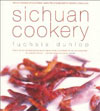 Buy it
Buy it
Before I had finished even half of Fuchsia Dunlop's introduction to her first cookbook, I was kicking myself for knowing so little about such a diverse and clearly delicious food region that's as big as France and more populous than Britain. Her entertaining descriptions of her time spent cooking in Chendung's famous cooking school combined with her simple, concise translations of what she learned made me yearn to start cooking immediately. I was in Chinatown a few days later, loading up on ingredients, though many are readily available in good supermarkets.
The recipes veer from the incredibly simple, such as stir-fried potato slithers with chillies to the more elaborate, such as dry-braised fish with pork in spicy sauce. Clear chapters cover cold food, poultry, fish dishes and street food. The vegetable chapter includes a recipe for fish-fragrant aubergine that is so simple and yet so good that it would convert anyone to Sichuan food. Concise sections detail most common ingredients and different cooking methods. You're left aching to visit the region, just to learn more.Thomasina Miers
8 THE CLASSIC ITALIAN COOKBOOK Marcella Hazan
(Papermac, 1973)
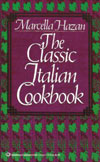 Buy it
Buy it
Marcella Hazan often gets the blame for the craze for balsamic vinegar, and she has been known to complain people use it far too much. But in other matters, her influence has only ever been benign. Hazan, knowing that some pastas are most definitely not best made at home, has made cooks everywhere feel truly proud of their jars of dried spaghetti. She has also, down the years, encouraged them to chuck out their garlic presses, and use instead the blade of a knife to crush our cloves. Best of all, she has taught us to elevate what we used to call spaghetti sauce to the status of ragu, an altogether more sophisticated beast. We know now to add milk to it, and nutmeg and, if we are feeling really chi-chi, we can throw in some chicken livers, too, and call it 'ragu di fegatini'.
The Classic Italian Cookbook was published in 1973 in America, where Hazan taught cookery in her New York apartment. Then, in 1980, it was adapted for a British audience by Anna del Conte, at which point she won herself a whole lot of new fans, plus an Andre Simon Award. It is a very good book indeed: comprehensive, straightforward, with recipes that really work. If you want to know how to make proper risotto, minestrone, or lasagne, this is where to look. But it includes other delicious things, too: pot-roasted squab, stewed rabbit, braised oxtail. As Hazan notes, the Italians like to describe such dishes as "un bocone da cardinale", or a "morsel for a cardinal". We don't know too many cardinals, but we know what she means: this is gloriously tasty food, to be cooked for those you really love. Rachel Cooke
7 THAI FOOD David Thompson
(Pavillion Books, 2002)
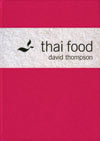 Buy it
Buy it
Australian chef David Thompson first went to Thailand almost accidentally when some holiday plans fell through, and was smitten by the country and its food. He moved to Bangkok, where he studied in the kitchens of people skilled in the noble arts of traditional cookery, pored over the memorial books that documented palace recipes, and explored the food sold on the streets. He originally promised his publisher a small book on Thai snacks, disappeared for years of intensive and obsessive research, and finally came up with this remarkable and comprehensive study of Thailand's culinary traditions. (With characteristic irony, he mentions in his acknowledgments that writing it was 'an interesting, prolonged experience'.) Within its gorgeous pink covers, you will find information cultural, geographical, historical, spiritual and culinary, not to mention a vast collection of recipes that range from street food through palace cooking, to exquisite desserts. It's a book of rare depth and complexity, demanding and exotic, and one that opened the door to a new appreciation of Thai cookery among readers of the English language.Fuchsia Dunlop
6 ENGLISH FOOD Jane Grigson
(Ebury Press, 1974)
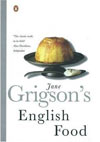 Buy it
Buy it
The great Jane Grigson, the Observer's food writer from 1968 until her death in 1990, was also the author of many wonderful cookbooks. It's perhaps debatable which is the best of these, but the one for which she will always be most celebrated is English Food. As the critic Fay Maschler put it: "She restored pride to the subject of English food and gave evidence that there is a valid regional quality still extant in this somewhat beleaguered cuisine."
English Food (it contains recipes from Wales, too) is undoubtedly a work of scholarship: carefully researched, wide-ranging and extremely particular. But it is also contains hundreds of excellent recipes, the vast majority of them short, precise and foolproof. Who could resist poached turbot with shrimp sauce, or a properly made Cornish pasty? As for the puddings, Grigson delivers recipes for some of our favourite ever: Yorkshire curd tart, brown bread ice cream, queen of puddings, and Sussex pond pudding. There is also an excellent – and blissfully long – section on teatime: every possible cake and bun is here in all their sugary, buttery glory. Rachel Cooke
5 ROAST CHICKEN AND OTHER STORIES Simon Hopkinson with Lindsey Bareham
(Ebury Press, 1994)
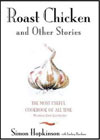 Buy it
Buy it
Simon Hopkinson is not a great cook because of his mastery of technique, though he has that by the bucketful. Nor is it his flair for innovation that makes him; even he would say his food cleaves tightly to the great European traditions. What defines him is his exquisite good taste. Nowhere is that better demonstrated than in this cleanly written, utterly reliable, delicious book. It is organised by ingredient – A is for anchovy, B is for Brains, P is for pork pieces and bacon bits – with a short essay on each. Then come the recipes, be it the roast chicken of the title – the trick is to rub it with butter and then squeeze over the juice of a lemon – one of his beloved tripe stews, or his saffron mash, pretty much the only dish he claims as his own invention. Pleasingly there is a direct link in this book back to the great Elizabeth David with recipes that she first introduced to these shores, such as the saffron soup with mussels or the heart stopping St Émilion au chocolat, refined for a modern palate. Jay Rayner
4 KITCHEN DIARIES Nigel Slater
(4th Estate, 2005)
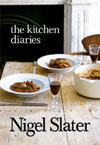 Buy it
Buy it
Nigel Slater is the Philip Roth of food. The towering writer of his generation by whom all others are judged. Or simply "a bloody genius", according to Jamie Oliver.Real Fast Food is Slater's Portnoy's Complaint, the bold and brilliant arrival, packed with precocious appetites and ideas, that changed for ever the thought of what to do with food in the cupboard or fridge. ButKitchen Diaries is the full flowering of a mature talent, with a clear knowledge of who he is, where he comes from and what he wants to say.
Moving on from Richard Olney's defining understanding of seasonality,Diaries places food back in the heart of the British home, the garden, the market, the farm. "Roast rhubarb on a January morning; pick-your-own strawberries in June; a piece of chicken on a grill on an August evening; a pot-roast pigeon on a damp October afternoon." The concept was simple but game-changing. British food from now on would celebrate the right food at the right time. Open it on any page (but start, say, with 1 January on page 4) and savour the simple beauty of the recipes and the writing.Allan Jenkins
3 THE BOOK OF JEWISH FOOD Claudia Roden
(Penguin, 1996)
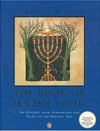 Buy it
Buy it
Cairo-born Roden has published many great recipe books, and there are few who can touch her knowledge of the Mediterranean and Middle East. But it is The Book Of Jewish Food which will stand as her masterpiece. In truth it is less a cookbook than a cultural over view of the entire Jewish diaspora, with appropriate recipes attached. It is a mark of just how reliable a piece of scholarship it is that, on publication, it was greeted with almost universal acclaim; a rare achievement for any work wading into the notoriously rancorous Jewish community. Every page and, more important, every recipe bursts with the vigour of a people that spent 2,000 years on the move. The dishes of the Sephardic Jews of North Africa and Spain are as rich and varied as you would expect of a writer who made her name with the food of the Middle East. Here are instructions for Iraqi date-filled pies, Tunisian couscous cakes and quinces in wine. More compelling still is her codifying of the eastern European Ashkenazi tradition: her irrefutable instructions for perfect chopped liver, latkes, gefilte fish and the rest. Any edition of this book is a joy, but the beautifully illustrated American version, published by Knopf, is particularly special. Jay Rayner
2 FRENCH PROVINCIAL COOKING Elizabeth David
(Penguin, 1960)
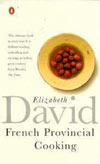 Buy it
Buy it
Elizabeth David came to me somewhat late, in cookery calendar terms. My mother, a very good cook indeed, had not, to my knowledge, a book of hers anywhere in the house when I was fettling away at the Aga in my early to late teens. Cordon Bleu, yes. Dad's dog-eared EP Veerasawmy paperback for his curries, indeed. But no Elizabeth David. It was not until I was 21 years old when friends in West Wales gave me a set of her Penguin paperbacks for my birthday, hoping that they may further inspire me in the kitchen of my little restaurant by the sea. Although I had already worked in a French restaurant and eaten in France with my parents, nothing compared to that which I was to learn and devour fromFrench Provincial Cooking. Nothing had previously evoked such a sense of place and time with the richest prose. It was and remains, intoxicating. The recipe for poitrine d'agneau Sainte Ménéhould is a case in point, where this meagre, though supremely flavoursome joint, is quietly poached with aromatics, cooled, carefully divested of its flacid, corset-like bones and excess fat, it is then pressed between weighted plates, or some such. Once firm, this now flat cut is sliced into thick strips, smeared with mustard, beaten egg and coated with breadcrumbs. Gently grilled, or fried till crisp – not 'crispy', a description Elizabeth David abhorred. This is a remarkably good plate of food. Simon Hopkinson
1 THE FRENCH MENU COOKBOOK Richard Olney
(Ten Speed Press, 1970)
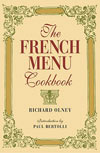 Buy it
Buy it
On a summer afternoon at his home in Provence in 1999, the American food writer Richard Olney went to lie down after a light lunch, and never woke up. He was 72, and had led an interesting and fulfilling life (his friends included the writer James Baldwin, the poet John Ashbery, and the painter John Craxton). He had also, unlike many people, been able to cook his own last meal. The story goes that when his brothers arrived to arrange the funeral, they found a plate and a glass by the sink. The plate contained traces of a tomato pilaff; the glass, red wine. The remaining pilaff was in the fridge. The brothers took it out, heated it up, and toasted him before tucking in.
This pilaff tells you everything you need to know about Olney. People favour risottos now, but before there was risotto, there was pilaff: buttery rice mixed with onions, garlic and tomatoes that have first been fried in olive oil. If the tomatoes are good and fresh, the oil sufficiently grassy, and the onions just so, this is the food of the gods. Olney was a hugely accomplished and knowledgeable cook, but his mantra was simplicity and, in this sense, he was ahead of the times. When The French Menu was first published in 1970, its determinedly seasonal approach was considered revolutionary. Four years later, he published Simple French Food, and his reputation was sealed.
Some read Olney for his uncompromising style alone. His sentences are longer than a prize pike; his salads are "composed", not tossed. Others like the way he pairs every dish with a wine. But it's his menus that really slay you. Olney lived alone, but he was a generous host, and his friends must have considered themselves truly lucky. Imagine a friend who cooked you sorrel soup, followed by frito misto, pheasant salmis with ceps, and an orange jelly. Or crayfish mousse, ravioli of chicken breast, roast leg of venison and moulded coffee custard. Or, perhaps best of all, cucumber salad, baked lobster, braised and roasted partridge, and fresh figs with raspberry cream. With this raspberry cream, we quietly rest our case.Rachel Cooke

No comments:
Post a Comment